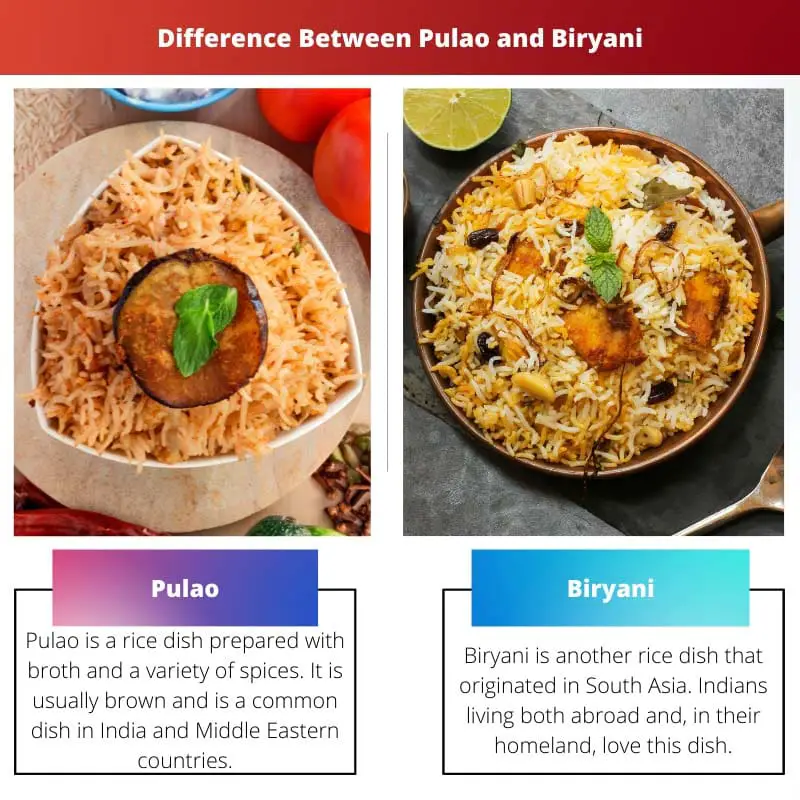When it comes to Indian cuisine, rice holds very important connotations. Whether it is the North or the South, either rice or roti is bound to be a regular item in Indian meals.
Due to India’s variety of cultures, a wide range of rice dishes can be found here, ranging from plain steamed rice to palak and tomato rice. However, the ones that are most liked and loved are pulao and biryani.
Key Takeaways
- Pulao is a rice dish cooked with vegetables or meat, while biryani is cooked with meat and spices.
- Pulao is less spicy than biryani, which has a strong aroma of spices.
- Pulao is cooked with basmati rice, while biryani is cooked with basmati and other long-grain rice.
Pulao vs Biryani
Pulao, also known as pilaf, is a rice dish that is made by cooking rice with a combination of vegetables, spices, and sometimes meat or seafood. Biryani is a more complex and time-consuming dish. Pulao is made with basmati rice, while biryani can be made with various long-grain rice types.

Pulao is a rice dish prepared with broth and a variety of spices. It is brown and is a common dish in India and Middle Eastern countries.
While preparing, various food products or additives, including vegetables and meat, are also added. These make the dish delectable and the most loved by Indians.
Biryani is another rice dish that originated in South Asia. Indians living both abroad and in their homeland love this dish. It is a very popular dish among Muslims and people from other parts of the world.
It takes time and a lot of practice to make a perfect biryani.
Comparison Table
| Parameters of Comparison | Pulao | Biryani |
|---|---|---|
| Origin | Believed to have originated in both India and Turkey | Originated in Persia and brought to India by the Mughals |
| Time is taken to prepare | Less compared to biryani | More compared to pulao |
| Spices used | Few spices and ingredients | Variety of spices |
| Smell | Moderate smell | Distinct heavy smell due to the spices used |
| Method of preparation | Absorption method | Dehydration method |
| Layering during preparation | Partial or no layers | Many layers of meat, rice, vegetables, onions used |
What is Pulao?
Pulao is an Indian dish cooked using spices, masalas, rice, and a variety of vegetables.
Various versions of pulao available in India include Matar Pulao, Tawa Pulao, Veg and Soya Pulao, etc. Sweet versions of this delicacy include Bengali mishti and Zafrani Pulao.
Whether a person likes spicy food or sweet one, pulao offers it all.
This easy-to-make recipe is prepared using the absorption method. The secret to making a perfect pulao is the spices that give it a unique flavour.
It is served with raitas.
There is a lot of debate regarding its origin as it has existed for a very long time in various parts of the world. It is said that the word pulao originated from the Sanskrit word ‘Pulla’, which means meat and rice.
The most common belief is that it originated in Turkey and travelled to India or it originated in India and travelled west.
The most distinguishing factor of pulao from other rice dishes is that each rice grain is separate and flavourful. Iranians make this dish with pistachios, saffron, zest, and a wide variety of meat.
While in Delhi, the pulao has evolved into a variety of biryanis. One can find a different variety of pulao in almost every region in India.

What is Biryani?
Biryani is a world-famous dish prepared with long-grained rice. It is layered with chicken, vegetables, lamb, fish, and thick gravy and flavoured with a variety of spices.
It is then covered with the lid secured and cooked at a low flame.
The origin of this dish, too, is debatable. It is mostly believed to have travelled to India and was introduced by the Mughals.
That is the reason why the city of Hyderabad is known for its mouth-smacking biryanis. Every region’s biryani differs from the others in terms of its flavours and ingredients.
The main parts of this dish comprise meat, marinade, rice, and spices. The most used marinade for meat is yoghurt spice.
Sometimes herbs and seeds also form a part of it, along with caramelized onion topping.
The most common types of biryani named according to the regions they are found are:
- Hyderabadi Biryani: The distinguishing element of this biryani is goat meat cooked side by side with rice, coconut, and saffron seasonings. It is the most famous type of biryani.
- Malabar Biryani: Cooked with ghee and Khyma rice, it is the only kind of biryani cooked in Kerala. It is a popular dish among the Malabar Muslim community.
- Mughlai Biryani: This richly flavoured dish is cooked with dry fruits, almond paste, curd, and chicken.

Main Differences Between Pulao and Biryani
- Pulao is believed to have originated in India and Turkey, as Turkish Pilaf is no different from pulao. On the other hand, Biryani was brought to India by the Mughals.
- Pulao is prepared with the absorption method, whereas Biryani is prepared with the dehydration method.
- Biryani has many layers while preparing, while pulao has almost no layers.
- Biryani takes comparatively more time to prepare compared to Pulao.
- Spices used in Biryani are more powerful, giving it a distinct smell. On the other hand, pulao contains fewer spices and is not coloured.
- While cooking, pulao is cooked on medium to high flame, whereas biryani is cooked for a long time on low flame.





